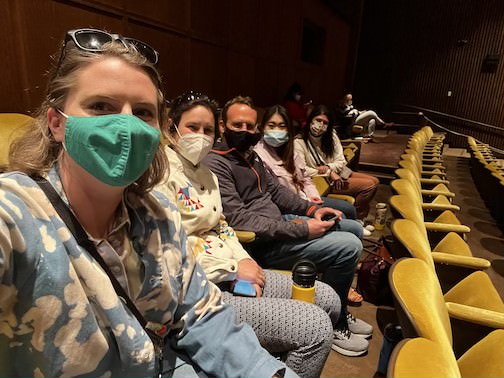Catalyst for Payment Reform, like many employers or teams, has operated in a fully remote work environment since the start of the pandemic. Last week, our team had our first in person retreat in over two years. I had the opportunity to meet most of my colleagues, other colleagues reunited, and it was a joyous affair replete with project planning, outdoor activities, and food.
We started off at the Epicurious Garden in Berkeley and hammered out the work plan; there are many exciting things in the pipeline for CPR. Unfortunately, one of the newest members of the team, Dayne Slay, was unable to attend in person but we had her on speaker phone. She was missed! We discussed CPR’s many projects and resources over the course of the meeting—too many to lay out here in detail, but a few highlights included brainstorming how we could make our education courses more accessible to employer-purchasers and discussing upcoming webinars. CPR put many hours of work into our courses ranging from Introduction to High-Value Purchasing to our Pharmacy Benefits Masterclass . These courses are at the heart of CPR’s mission as a 501c3 educational non-profit, so we want to see them used as much as possible. Regarding upcoming webinars, be on the lookout for an event re-introducing our Aligned Sourcing & Contracting Toolkit!
After the work plan meeting we broke for lunch, enjoying the many vendors available in the Epicurious Garden.
Once we completed project planning, the remainder of the retreat was dedicated to team bonding! We started at Suzanne Delbanco’s house, where we enjoyed tea and cookies in her enchanting backyard in the foothills of Berkeley. While we were enjoying the afternoon, a scrub jay flew closely overhead and threatened, briefly, to land on our heads – we realized quickly that we were sitting underneath the vine where she had a nest and so were able to hear the chirping of her baby birds as she arrived with food. Suzanne grows lemons, limes, herbs, and figs in her garden – all ripe enough to pluck and eat or garnish your tea with, and we were the beneficiaries of a little bit of the crop.
Then, we hiked to Live Oak Park, near Suzanne’s for an exciting game of Kubb, also known as Viking Chess. The game consists of 10 small kubbs, one large kubb (the King), and six throwing sticks. The game is marked out in a rectangle with four wooden stakes; we opted for a smaller rectangle as it was our first time playing. Five of the kubbs are lined at the shorter ends of the rectangle across from each other with each team standing behind their line of kubbs. The King is placed randomly near the center line of the inner rectangle. The object of the game is to knock over the other teams kubbs, then knock down the King. The first team to achieve this wins!



Julianne McGarry graciously invited us over for wine and nibbles on her deck, which overlooks Berkeley and the Bay.

We devoted the retreat to team bonding because for most of the staff, this was the first time we had seen each other since the pandemic. We had yet to celebrate some pretty big life events, such as two weddings! Andréa Caballero and Ryan Olmstead tied the knot to their respective partners, and while staff had joined over Zoom, we had yet to give them each a congratulatory hug. We also hadn’t shared a meal in two and half years, which was why our last stop of the day at Ryan Olmstead’s house was so special. Catered by Market Hall Foods in Berkeley, we started off the evening with an assortment of cheese and crackers followed by a tasteful meal of salad, deviled eggs, stuffed eggplant, and salmon. Ryan also lives in Berkeley, which by this time it seemed that we had walked most of. We examined how much sun we had all received from being outdoors all day, and some of us turned in that night with sunburnt foreheads.
On day two, we began at Standard Fare and Third Culture Bakery, the latter serving up delicious mochi donuts and matcha lattés. I had my employee headshots taken with the lovely Kirsten Getchell, as staff enjoyed a chilly, but sunny, breakfast. The best part of the second day was that it was Kathy Flock’s birthday. Kathy is CPR’s director of operations; happy birthday Kathy!

After breakfast, we ventured to UC Berkeley’s campus for a noon Gamelan Concert. A Gamelan is an orchestra made up of a set of instruments from Java and Bali, Indonesia. It was mesmerizing! Lea Tessitore put it perfectly when she said that she felt hypnotized, and nearly drifted off because of how soothing the music was. We finished the day and retreat at Gather, a restaurant located near the university. We celebrated Kathy’s birthday, which wrapped up a month in which fifty percent of CPR’s staff have birthdays!


The retreat was a wonderful reminder of why it is such a pleasure to work at Catalyst for Payment Reform. It is the thoughtful leadership and the friendships forged amongst colleagues that keep the fire alive at the organization. And the team bonding was great for our mental health. If you have been the beneficiary of any of CPR’s resources, know that behind the scenes is not only a courageous and capable crew, but also a tight knit team who truly cares for one another.
Looking forward to the next one!
CPR’s Operations and Marketing Associate, Torie Nugent-Peterson, wrote this blog post.


